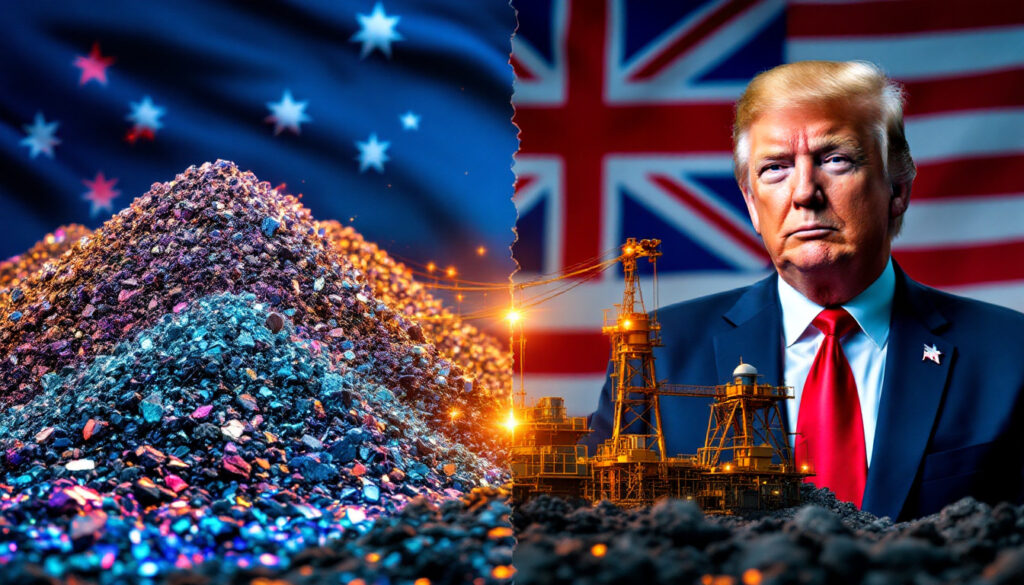What Is Australia's Five-Point Plan to Counter US Tariffs?
Australia has unveiled a comprehensive five-point plan in response to President Donald Trump's recently announced tariffs on Australian imports entering the US market. The strategic response includes immediate financial relief, longer-term investment opportunities, and a focus on leveraging Australia's critical minerals advantage in global supply chains.
At the core of Australia's response to US tariffs is a substantial financial commitment: $50 million in immediate support for sectors directly impacted by the US tariffs, complemented by $1 billion in zero-interest loans through the National Reconstruction Fund Corporation. These measures aim to cushion the blow for Australian industries facing the 10% baseline tariff set to take effect on April 5, 2025.
Warren Pearce, CEO of the Association of Mining and Exploration Companies (AMEC), noted: "The government's response demonstrates a clear understanding of the strategic importance of our resources sector, particularly critical minerals, in navigating these trade challenges."
Beyond financial support, the plan includes strengthening Australia's position in domestic markets through prioritization of Australian-made products, enhancing anti-dumping laws to protect vulnerable sectors like steel and aluminum, and perhaps most strategically, establishing a Critical Minerals Strategic Reserve.
How Will the Critical Minerals Strategic Reserve Work?
The Critical Minerals Strategic Reserve represents a cornerstone of Australia's strategic response, positioning the nation to leverage its abundant natural resources in a changing global trade landscape.
"Australia is a critical minerals powerhouse," explained Warren Pearce of AMEC. "The Strategic Reserve offers us a unique opportunity to strengthen our position as a reliable global supplier while creating domestic benefits for our mining sector."
The reserve is expected to function through multiple mechanisms:
- Creating a strategic stockpile of minerals deemed essential for modern technologies and defense applications
- Incentivizing domestic exploration and production through guaranteed purchase agreements
- Establishing baseline price supports that reduce market volatility for producers
- Developing processing capabilities to move beyond raw material exports and capture more value domestically
Industry analysts suggest the reserve could initially focus on minerals where Australia holds significant global reserves, including lithium (where Australia currently provides nearly 50% of global supply), rare earth elements, cobalt, and high-grade nickel deposits.
Geological advantages put Australia in a particularly strong position with some mineral deposits containing unusually high concentrations of rare earth minerals—sometimes 2-3 times the global average grade—making extraction more economically viable even during market downturns.
Why Aren't Critical Minerals Included in US Tariffs?
The explicit exclusion of critical minerals from President Trump's tariff policy reveals significant strategic calculations behind US trade policy. This exemption creates a substantial opportunity for Australia to strengthen its position in global supply chains.
The US currently depends on imports for more than 80% of its critical mineral shortages needs, with China dominating global supply chains for processing many of these materials. Australia, with its politically stable governance and abundant resources, represents a preferred alternative supplier for the United States.
"The tariff exemption for critical minerals isn't coincidental," noted Pearce. "It reflects recognition that the US cannot quickly develop domestic capacity for these materials and that Australia represents a reliable, trusted partner in securing these strategic resources."
This dependency gives Australia significant leverage in negotiations, as the US Defense Department has identified over 50 minerals as "critical" to national security, many of which Australia possesses in commercially viable quantities.
US geological surveys estimate that replacing Australian critical mineral imports would take 5-7 years of intensive domestic development, creating a window of opportunity for Australia to consolidate its market position.
What Financial Support Is Available for Affected Industries?
The Australian government has committed substantial financial resources to help industries navigate the impact of US tariffs, with targeted support for those facing the greatest disruption.
The $50 million immediate assistance package will focus on:
- Market diversification initiatives to identify alternative export destinations
- Supply chain reconfiguration support to reduce dependency on US markets
- Trade facilitation programs to streamline entry into new markets
- Strategic planning grants for businesses requiring significant operational pivots
Beyond this immediate support, the $1 billion zero-interest loan program through the National Reconstruction Fund Corporation represents a longer-term investment in industrial resilience. These loans will support:
- Capital investments in new processing technologies
- Efficiency improvements to maintain competitiveness
- Research and development initiatives
- Value-adding capacity to serve domestic and alternative international markets
"These financial measures provide both immediate relief and longer-term strategic investment," explained an industry analyst. "The zero-interest loans are particularly significant, as they enable capital-intensive industries to make transformative investments without prohibitive financing costs."
Why Is Australia Not Retaliating With Tariffs?
Australia's decision to avoid imposing reciprocal tariffs on US imports represents a calculated approach to trade diplomacy and economic self-interest. This non-retaliatory stance has garnered support from industry bodies including AMEC.
"We don't stand to benefit from adding further fuel to the fire," stated Warren Pearce of AMEC. "Australia's position as an export-dependent nation makes tariff wars counterproductive to our economic interests."
This approach reflects several strategic considerations:
- Australia exports approximately 20% of its GDP, making it more vulnerable to trade disruptions than larger economies with substantial domestic markets
- The US remains Australia's third-largest trading partner and a critical source of investment capital
- Previous trade disputes have demonstrated that smaller economies typically sustain greater proportional damage in tariff escalations
- Maintaining open dialogue positions Australia more favorably for potential negotiations once the immediate political climate shifts
Economic modeling suggests that for every dollar of tariff imposed by Australia, domestic industries would face approximately $1.75 in retaliatory measures and market access limitations—a poor return on investment by any measure.
Australia's careful approach contrasts with more aggressive stances taken by other trading partners. According to the US tariffs analysis by economic experts, restraint may ultimately preserve more market access than confrontation.
What Are the Implications for Australia's Mining Sector?
The US tariff policy and Australia's strategic response create a complex landscape of both challenges and opportunities for the mining industry, with critical minerals positioned as the clear winner in this trade realignment.
Potential Benefits for Critical Minerals
The exemption of critical minerals from US tariffs creates significant opportunities for Australian producers, particularly as global demand continues to accelerate. Industry projections suggest lithium demand could increase by 400% by 2030, with similar trajectories for other battery minerals and rare earth elements.
The Strategic Reserve initiative could provide particularly valuable stabilization for volatile minerals markets. Lithium prices, for example, have fluctuated by over 300% in the past three years, making investment decisions challenging for producers.
"The Strategic Reserve could provide a price floor effect," noted one mineral economist. "This would reduce investment risk and potentially unlock projects currently considered marginally economic."
Geologically, Australia possesses among the world's highest-grade deposits of several critical minerals. Western Australian lithium operations typically yield spodumene concentrates with 5.5-6.5% lithium oxide content—substantially higher than many international competitors who often work with grades below 4%.
The mining industry role in the clean energy transition makes these developments particularly significant for Australia's economic future.
Challenges for Other Mining Sectors
While critical minerals enjoy protected status, other mining sectors face adjustments:
- Traditional bulk commodities entering the US market will face the 10% baseline tariff
- Supply chains built around US customers may require reconfiguration
- Investment timelines may extend as market uncertainty increases
- Regulatory compliance costs could rise as both Australian and US authorities increase scrutiny of trade flows
Analysts suggest the coal sector could face particular challenges, as the 10% tariff compounds existing market pressures from decarbonization initiatives. Australia exported approximately $4.7 billion in coal to the US in recent years, much of which could face displacement under the new tariff strategies reshaping markets.
FAQ About Australia's Response to US Tariffs
When will the US tariffs come into effect?
The baseline 10% tariff on Australian imports will come into effect on April 5, 2025, giving affected industries approximately five months to prepare and implement adjustment strategies. This timeline represents a somewhat shorter adaptation period than provided in previous major trade policy shifts.
What sectors are most affected by the US tariffs?
While the full sectoral impact analysis remains under development, steel and aluminum producers have been identified as particularly vulnerable. These industries operate with tight margins and face significant global competition, making the 10% tariff potentially disruptive to established business models. Other sectors likely to experience notable impacts include processed agricultural products, certain manufactured goods, and non-critical mineral resources.
How will the Critical Minerals Strategic Reserve be funded?
The funding mechanism for the Critical Minerals Strategic Reserve hasn't been fully detailed, with Warren Pearce of AMEC noting that industry will "have to wait to see the detail of this proposal." However, preliminary discussions suggest a public-private partnership model that could include government appropriations, industry contributions, and potentially sovereign wealth fund investment. The reserve's funding structure will likely involve staged implementation, beginning with a core set of minerals deemed most strategically significant.
What is AMEC's position on Australia's response?
AMEC has expressed strong support for the government's multifaceted approach, particularly praising the Critical Minerals Strategic Reserve concept and the decision to avoid retaliatory tariffs. The organization views the response as appropriately calibrated to protect Australia's economic interests while maintaining diplomatic space for future negotiations. AMEC has indicated particular support for measures that strengthen critical minerals development, an area where its members have significant investment and operational interests.
How does this response compare to previous trade disputes?
While historical context wasn't extensively detailed in the transcript, Australia's approach demonstrates evolution from previous trade tensions. The focus on strategic positioning rather than direct confrontation represents a more sophisticated response than seen in some historical disputes, recognizing the complex interdependencies of modern global supply chains. The emphasis on critical minerals leverage represents a targeted approach to using Australia's natural advantages rather than broad-based retaliatory measures.
This approach aligns with industry predictions for 2025 that highlighted geopolitical realignment as a key factor for mining and resources. Meanwhile, recent analysis shows that Trump's policies are simultaneously creating other market distortions, particularly in precious metals markets.
According to recent tariff policy analysis, Australia's measured response may position it better for long-term trade relationships than countries pursuing immediate retaliation.
Want to Know About Major Mining Discoveries Before the Market?
Stay ahead of the curve with Discovery Alert's proprietary Discovery IQ model that delivers real-time notifications on significant ASX mineral discoveries, turning complex mining data into actionable investment insights. Explore how historic discoveries have generated substantial returns by visiting Discovery Alert's dedicated discoveries page and begin your 30-day free trial today.




